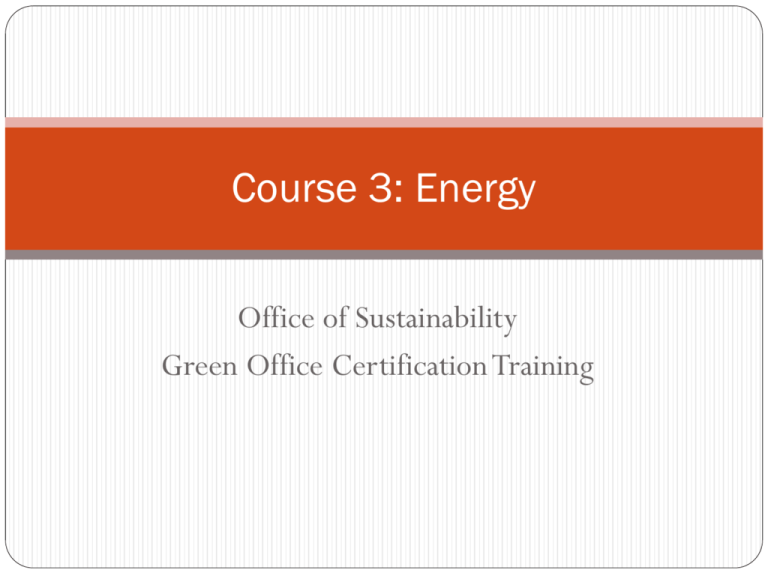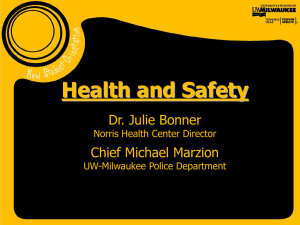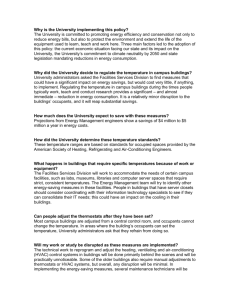Course 3: Energy
advertisement

Course 3: Energy Office of Sustainability Green Office Certification Training Energy at UWM Energy is an important aspect in the workplace because it heats and cools our buildings, operates our labs, lights our desk, and powers our computers. However, energy usage is costly to the environment and the bottom line. In response to these issues, UWM is taking positive steps towards reducing its overall energy usage by implementing a program called Energy Matters, conserving through the Heat Plant, and investing in renewable energy resources. Through these initiatives UWM will not only save state dollars, but it will also reduce the amount of greenhouse gases sent into the atmosphere. Although the university is taking great strides in reduce energy usage, it is also the role of every student, staff, and faculty member to contribute to these efforts because operational changes can only go so far. Energy Matters In 2005, through Executive Order 145, Governor Doyle ordered all UWSystem institutions to reduce energy consumption. Using 2005 energy consumption as an institution's benchmark measurement, UW-Milwaukee joined other UW institutions to use 10% less energy by 2008 and 20% less by 2010. When UWM recorded a 5% increase in energy consumption by 2008, the university made a decision to reduce energy consumption by 25% by 2013 to get to the original 20% reduction mandated by the governor. To achieve this goal, the university went through performance contracting-a process where a contractor audits buildings to review their energy usage and then makes recommendations as to how to make the building "perform" better and use less energy. Energy Matters From this process, Energy Matters was created. Energy Matters is UWM‘s energy efficiency project with a goal to: 1) Achieve an energy reduction of 25% by 2013 2) Reduce campus use of fossil fuels 3) Provide comfortable study and work space Energy Matters is broken down into 5 phases, with each phase focusing on a different set of buildings across campus. During each phase contractors from different companies improve features of the buildings, such as: -Upgraded lighting in offices and classrooms: lighting is more natural -Improved indoor air quality -Occupancy based heating and cooling: buildings adjust to state mandated temperatures -New digital controls Contractors from various companies working on Energy Matters Energy Matters 4 Million + Square Feet Covered $33 Million State Investment 25% Reduction Goal, by 2013 30% Reduction overall, across campus 2013 saw $4 million saving come back to campus PC Power Management In conjunction with Energy Matters, computers labs across campus have been equipped with PC Power Management, a system designed to power down computers and monitors during idle time. “Wake up” takes just a wiggle of the mouse or keystroke. Verdiem Software SCCM Renewable Energy Along with energy efficiency updates, UWM invests in renewable energy sources. Investing in renewable energy is important because it helps lessen our dependence on fossil fuels. UWM’s main source of renewable energy comes from Solar Electric (PV) systems. Bolton Hall- This 74 panel solar energy installation is a perfect example of using the campus as a living laboratory. The drive behind this installation is research being conducted by UWM’s College of Engineering and Applied Science. Each panel produces 205 watts. Bolton Hall Solar Panels with researchers who helped implement project Another source of solar electric comes from the 30-kilowatt system of solar cells on the Golda Meir Library Green Roof that is sponsored by WE Energies, with the support of Focus on Energy grants. Cambridge Commons also has a solar photovoltaic system, installed when it was built as a LEED Gold building. 30 kilowatt system on Library Green Roof Purchasing Renewable Energy By working with our local utility, WE Energies, UWM has been able to purchase renewable energy. The purchase by UW institutions as a whole comes out to 70,383,875 kWh (as of 2013), and is expected to grow once the total purchase is equal to 20%. The State will purchase annually 92,400 megawatt hours of renewable electrical energy. Building Dashboard In conjunction with Energy Matters, the Building Dashboard has been created to allow users to view energy usage in buildings across campus, in real time. The dashboard is an interactive, 24-7 meter that measures kilowatt-hours per building, as well as the amounts of chilled water and condensate used by each building. Users can view the electricity, water, and heating of buildings at http://buildingdashboard.net/uwm/, or on the homepage of The Office of Sustainability website, www.sustainability.uwm.edu. On the website simply click on your building to track its energy usage by day, month, or even year. See energy consumption in kilowatts, carbon dioxide, or dollars. Heat Plant Conservation Measures Due to a well trained and experienced staff, UWM’s Heat Plant has made many strides over the years to implement conservation measures. The outcomes of these measures have been well documented and are one of the finest examples of sustainability at UWM. The Central Heating and Chilling Plant provides 37 campus buildings + NWQ with steam, chilled water and compressed air. It also operates 6 satellite boiler plants and 1 additional Centralized Heating Plant used to heat buildings not serviced by the campus central utility system. The plant is capable of producing 422,000 Lbs of steam per hour, 12500 Tons of cooling and pumps up to 31.5 million gallons of lake water to campus each day used to reject heat from campus buildings via its chilling equipment. By using Cooling-Building Control Installation and Setback Programming, and Heating-Building Control Installation and Setback Programming, Total Campus Related Savings= $6,480,588 Water Conservation Through Phase IV of a Wisconsin Energy Initiative in the year 2000, UW-Milwaukee was able to greatly reduce its water usage. Johnson Controls Inc. estimated a 46.6 million gallon reduction annually, a proposed cost savings of $142,728 per year. Through Energy Matters fixtures are being adjusted to make sure they’re running correctly, improving the efficiency and reducing water usage. Office Energy Savings Vampire Load Many appliances in break rooms and conference rooms have idle currents which mean the appliances are drawing electricity even when they appear to be off (vampire load). While the idle current of each individual appliance doesn’t amount to much, all together this wasted energy accounts for 5-7% of our nation’s total energy consumption. To eliminate idle currents, departments should unplug appliances or attach them to a power strip and turn the power strip switch off when the appliances are not in use. Temperature In accordance with Governor Jim Doyle's Executive Order 132 dated November 21, 2005, the Department of Administration issued guidelines related to temperature, humidity, hours of operation and other variables that affect energy usage. The main focus of the regulations is thermostat settings, which will be 68 degrees in the winter and 76 degrees in the summer. Through Energy Matters, buildings on campus adjust to these temperatures based on occupancy of rooms. Set back a few degrees when unoccupied, but never completely off. Space Heaters Space Heaters should not be used in offices, as the heating is already on in all buildings. Space heaters can actually make buildings colder because when they are placed near thermostats the system thinks it is already warm enough and does not properly heat the building. In accordance with Governor Jim Doyle's Executive Order 132 dated November 21, 2005, the Department of Administration the use of space heaters and fans is prohibited. (http://www4.uwm.edu/usa/risk/policies/heaters.cfm) Lighting New, improved lighting (25 watt, 5,000K lamps) through Energy Matters has drastically reduced the amount of energy used by lighting on campus. However, you can help reduce energy even more by replacing the light bulbs in your desk lamp with CFL bulbs. Changing your light bulbs can make a big difference. A CFL uses 75% less energy than an incandescent bulb, and lasts up to 10 times longer. For example, if your department switches fifteen 60W traditional incandescent bulbs with fifteen 60W-equivalent CFLs, you will save an annual 756 kWh = 396 lbs CO2 avoided = $75 in energy savings each year (assuming CFLs are used 4 hours a day for 300 days per year). Community Appliances -Eliminate any personal refrigerators and utilize only break room appliances. By itself, your mini fridge doesn’t use a lot of energy, but when all other fridges in the department are taken into account, it adds up to a lot. Sharing a communal fridge rather than using your own will decrease energy usage and increase financial savings. -Eliminate individual office printers and instead use network communal printers/copiers. Individual printers are unnecessary because they require extra ink cartridges and paper. Utilizing a communal printer/copier reduces the amount of energy being used by the department Equipment Placement Keep all copiers and printers at least 10 feet away from thermostats and sensors. Copiers and printers give off heat when they are turned on, and the heat emitted makes thermostats or sensors think the room is warmer than it actually is. The thermostats then have to work harder and keep the room colder than it has to be. By keeping the copiers and printers at least 10 feet away from all thermostats and sensors the room temperature can remain at the correct temperature and keep your department comfortable.






